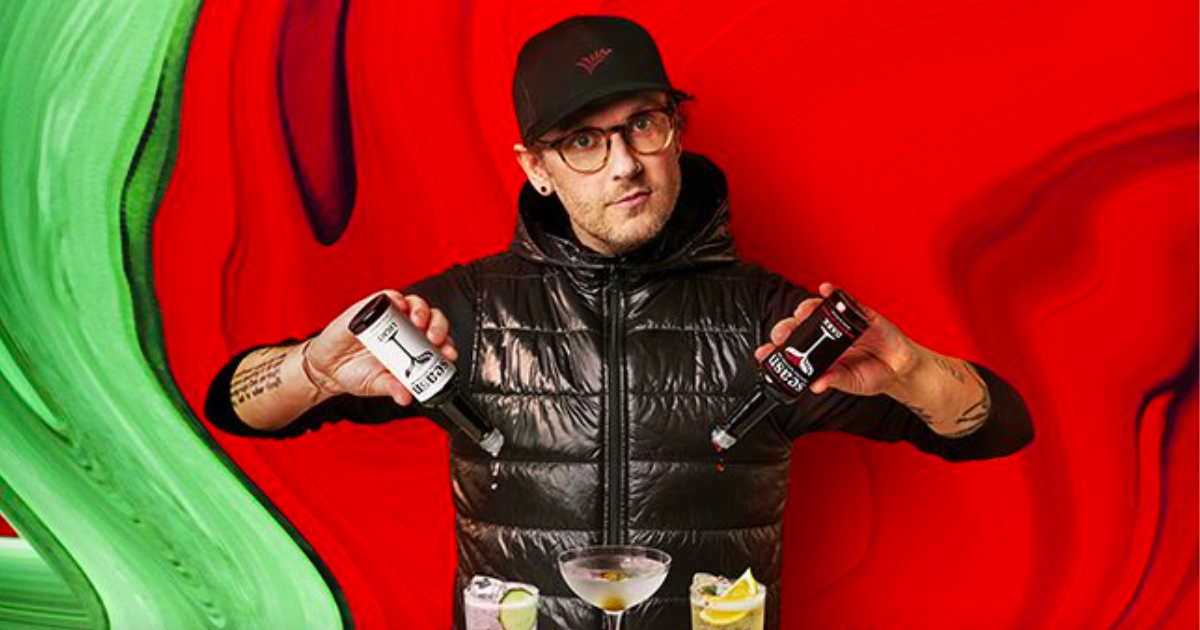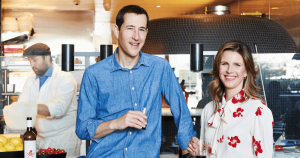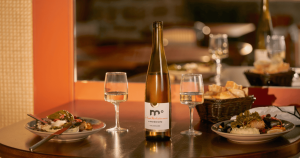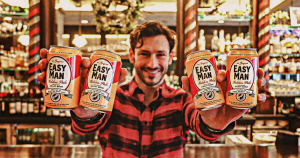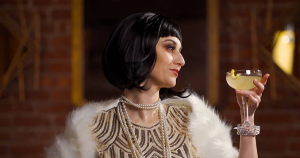Ben Branson, known as the “Founding Father of Non-Alc” and the creative mind behind Seedlip, shares his journey from the brand’s beginnings to its acquisition by Diageo. He opens up about the unique challenges of introducing a completely new product to the market, and his experience repeating that cycle with his latest brand, Seasn. This candid interview offers a fascinating peek into Branson’s creative approach and his consistent drive for beverage innovation.
When you started Seedlip, the non-alc space was basically O’Doul’s and nothing else.
And Beck’s Blue in the UK.
There you go. So we’re not exactly talking about anything complex. You launched Seedlip with no precedent. Tell us a bit about your intuition, your instinct. What gave you the conviction?
It wasn’t that one day I decided: I’m going to create a distilled non-alcoholic spirits brand, I’m going to start this non-alc movement, and it’s going to be a business. It was a very, very gradual process. For my initial idea, I just wanted to do this on the side and take it to a farmers market.
To be honest, if I wanted anything, it was, “hey, look, I’ve been working on other people’s brands and I’ve discovered I can do this cool thing with distillation… I think it’d be a fun project to do my own brand and put something in a bottle and put a label on it.” That was it. That was really how it started.
Then I literally emailed the 500 best bars, restaurants, and hotels in the UK, which was obviously completely free to do. I just said the exact same thing to all of them: “It’s my friend’s birthday, they’re pregnant, and we’d love to come to your bar/restaurant/hotel. What options do you have that are non-alcoholic?” The results told me everything. Some people didn’t reply. This was a five-star hotel or a Michelin-star restaurant not replying! That told me quite a lot. Some people replied and said, “we can make you something on the day,” and that told me a lot as well. It was an afterthought. Some people sent me their soft drinks list. Some people sent me their mocktail list—basically a whole load of juices and syrups dressed up.
We’re talking late 2013, early 2014. What’s out there? Shit, nothing’s out there. Some people might go, “yeah, but that’s told you that nothing’s out there so people don’t want it, so don’t fucking do it.”
That was going to be my next question.
Instead, I was like, “okay, maybe there’s a gap.” It was a dot joining exercise of what’s in the news, what is the press focused on. We’d moved on from 10 years prior, from photographs of people falling out of nightclubs, from chaos and excess being aspirational and attractive. We’d moved on to things like green juices and yoga. People were a bit more informed, and social media meant that people cared a bit more about how they were perceived.
I was correlating: there’s nothing out there, but then there’s this shift in values happening. So I pieced those two together. Maybe what’s needed is a really great grown-up option if you’re not drinking alcohol for whatever reason. Enter Seedlip.
There were no focus groups. It was very inward-focused and very solitary in that sense. I must be sort of deludedly brave because I just thought, well, I’m going to take it to the best palates. And if they think there’s something in it, then I’ll properly put this in a bottle and go for it. And if they think it’s rubbish, then I might think again. Five of the best bartenders in London and the best spirits buyer—who is also a master of wine—they all fucking loved it.
So I was like, great, I’m going to bottle 500 bottles. Then I got a bit more confident and thought, actually, I’m going to bottle 1000 bottles. I was full time on it at this time. I started to flip between thinking, “I want to change the way that the world thinks about drinks. I’m going to take over the world,” mixed with “this is the shittiest idea ever, this isn’t going to go anywhere, I really don’t want to do this.” Seedlip made some people really angry. They were saying really nasty things about it. I was conflicted.
Ironically, I’m right back in that exact same conflict right now, two weeks in, having launched Seasn.
Perhaps it’s just an indication that you’re on the bleeding edge of innovation. You’re presenting things to society that people don’t have a frame of reference for. I imagine, on one hand, that’s terrifying. But, on the other, you’re peerless. Your past is so interesting, and you’re repeating a similar cycle in the present. Tell us a bit about Seasn.
Thanks for those kind words.
It was two years to develop Seedlip. I had no clue what I was doing. No experience in the drinks industry. No experience in product development. No experience in distillation. No experience running a business. Ironically, Seasn has taken six years. That’s not because I’ve been tweaking the product every day for six years to try to get it right. But it’s been a process.
I started making individual flavor bitters that were 0.0% ABV back in 2017, because of two things. One, I wanted to have more things that could go with Seedlip. We were on our own until 2018. Second, I’d learned that there are 47,000 edible plants in this world and I wanted to taste more stuff. Doing a glycerin extraction of a plant is a great way to taste it. I ordered all these different herbs and spices and seaweeds—lots of things that were mentioned in The Art of Distillation, lots of things I’d never heard of. Most of them actually tasted really, really disgusting. There’s a reason why bogbean hasn’t made it into the public sphere of condiments and seasonings. But I found the process interesting.
Seedlip was still my focus. When we did the majority exit [to Diageo], I picked the bitters project back up with more learning, understanding, and focus. Food, flavor, cooking, I love. I left school when I was 18 and trained to be a chef. I have more of an affinity with a chef than a bartender. So I started approaching it slightly differently, thinking about it from a food perspective, from a seasoning perspective. What’s going on in cocktail bitters? Getting my head into cocktail bitters started to unearth the answers.
People don’t really know what cocktail bitters are. The category has this sort of dusty, apothecary, secret bartender-y thing going on. I wondered if we could expose it to the public, and really give them something that was simple and relevant to them. I realized Seasn didn’t need to be product after product after product—huge, unwieldy ranges of individual flavors. I decided to do two products and set the limit there. We’re going to frame it as the salt and pepper of drinks. We’re going to call it Seasn. We’re going to ask people to season their drinks. My aim is to show people how easy and delicious drinks can be by just adding three dashes from these little bottles.
It just so happens that a really good way to make cocktail bitters doesn’t have to use alcohol. So, if I didn’t need to use alcohol, I didn’t use alcohol. I’ve used vegetable glycerin as our solvent instead, and as our base. That means that people can use this as vegan, as allergen-free, as 0.0% ABV. Anybody can use these products, no problem. I think it’s quite cool that they can put it in anything they want to put it in. Be that alcohol, non-alcoholic drinks, food. I was just putting Seasn Dark in my chicken noodle soup the other night. I want this to be freer and less serious. Just really simple for people to use.
I did notice with your messaging you make it clear: while these are 0.0% ABV, use it in a non-alcoholic or alcoholic beverage. I wonder if that reflects something I’m seeing, the movement toward flex drinking, where it’s less of this binary: do you drink or not? With Dry Atlas, we don’t use the phrase sober curious, which makes it feel like you’re on the precipice of this serious lifelong decision.
It just doesn’t fucking sound very positive.
Not at all. I actually really like how Diageo puts it with “positive drinking.” So, I’m curious, as you decided to move forward with Seasn, was your formulation and positioning informed by any kind of evolution you observed within consumer attitudes toward alcohol?
Yes and no. With Seedlip, we never targeted people who are sober. The stats are overwhelmingly that moderation is what people are doing. And they are drinking alc and non-alc on the same occasion, in the same week. I personally don’t understand how people can base their identity around something they don’t do. I don’t understand that. Seedlip was always for moderators and Seasn is absolutely for moderators, too.
Seasn is really for anyone. Because it’s even less grounded in “hey, this is what you can drink when you’re not drinking alcohol.” It’s even less specific on that occasion and that need. If it’s specific to any need, it’s the need to make something that has real taste and flavor and deliciousness. So, no, in quite a lot of ways, I don’t think Seasn changes much from an audience perspective because we’re still focused on moderators.
What Seasn does do differently—what I’m interested in and proud of—is that the 0.0% ABV is just a claim. It’s as important to me as the fact that it’s vegan and sugar-free and has no allergens. I do wonder, when you fast forward the tape—that could be Seedlip, that could be Seasn, that could be any of the non-alcoholics—will that 0.0% ABV or non-alcoholic shouting match on the front of the label just move to the back?
It’d be amazing if the alcohol content of products weren’t a core part of their identity. And that’s what alcohol does, right? It’s just stated, the ABV. It’s got the right stuff on the back, legally. I’d love to see the alcohol content, in very simple visual terms, just move to the back of the bottle.
That’s a fresh perspective. I just read a marketing research report from the UK that advised exactly that: non-alc brands should stop centering their messaging or, in some cases, their brand identity on the concept of non-alc. Consumers care more about what brands are offering them, not what they’re not, which goes back to your self-identification point. Why would you identify yourself by what you’re not doing versus what you are?
It’s really funny, when someone asks me what I do, I just say, “I’m in drinks.” And they immediately think that means alcohol. I could be in milk, for God’s sake! There’s still a hell of a long way to go in terms of societal norms.
I basically think: if you’re building a brand and the ABV of your brand is a core part of your name or your packaging—dangerous red flags. I’d be starting to re-think that.
That’s great advice for the emerging founders in our community. I’m curious, shifting gears to Pollen Projects, Seasn is the first of what will be many launches to come out of your venture studio. Can you talk a little bit about why you decided to go the venture studio model versus standalone brand? What’s your thesis for Pollen Projects?
Pollen Projects is a brand new, totally independent venture studio dedicated to non-alc and moderation in its entirety.
So, it’s not just about products and brands. It’s about looking at the whole ecosystem. The venture studio bit simply means that we’re not an accelerator or an incubator. We’re not kind of bringing in other people’s brands and giving them a bit of coaching and sending them on their way in 12 weeks’ time.
We’re hands-on, we’re operational. These are my ideas that we are commercializing. We don’t want to do loads. It’s not like what they can do in tech, which is like light loads of fires and see what sticks, and then back the winners. Food and drink takes longer. You can’t just decide to put something out there tomorrow or even just change it the next day. It’s about doing premium ideas that are disruptive, that look at under-leveraged opportunities and under-leveraged profit pools across the whole non-alcoholic value chain. Seasn is that first project.
I firmly believe that Seasn is launching at the time it’s meant to. If I’d launched it six years ago, it’d be the wrong time. I need to find the right way of embracing patience, because I am very impatient, and Seedlip was very, very fast. I’ve got a lot of energy to do great stuff. But, at the same time, I have a really helpful break in my brain that means we will not do anything unless it’s really considered and it’s the right time to do it.
We only launched three products at Seedlip. We still only have three products at Seedlip, and Seedlip’s been going for eight years. We did innovation in different formats, but I’m a big believer in: just because you can doesn’t mean you should. By deliberately creating some of our own rules with Seasn of having Light and Dark, it forces a focus that means you don’t get carried away. Because there’s so many things I would love to create and produce and try. You’ve got to throw one tennis ball to the consumer and not ask them to catch 10 at the same time.
I imagine that discipline is hard. How do you stay the course when you have such a creative brain that’s spinning out new concepts all the time? How do you decide: now is the time for Seasn, here’s how long we’ll focus on this, and here’s what’s next?
It’s this push and pull. For example, I can get very excited about an ingredient. Like I’ve just discovered a natural flavor enhancer that’s really umami—I need to try it, understand it, and pick it apart. What could it be used for?
But that’s one moment and then I’ll leave it alone. I might come back to it in three years’ time, or in two years, or one year. It’s a bit like cooking, a sort of marination process. I have a great idea and it’s banked and it’s not going anywhere. I know that, when I come back to it at some point, it might be rubbish and irrelevant. Or I might get the enjoyment of being able to think on it and explore it. It’s a bit like having lots of presents that you are not allowed to open yet. But, at some point, you’re going to be able to go and open the present. You might not like what you find. It might not be any good anymore, but you can have the moment to kind of open it and the reward of: yeah, you can have half an hour with that present. Have a think about that.
Time is the finite thing, right? I’ve got three kids, it’s a busy house. I’m launching a charity and a podcast in January. Obviously Seasn has just launched. I’ve got a US trip coming up in January for Seedlip for some exciting stuff. I’ve got plenty to do. I don’t have that luxury of, oh, I’m just going to create another thing today.
I love your present analogy. It goes back to the kind of flexible thinking you’ve exhibited throughout this discussion. Things don’t need to be so binary. Just because you’re shelving something doesn’t mean it’s dead. In fact, it might spring to life in a better way years later, just as you saw with Seasn.
I love holding the tension. There’s so many binary views in business and in brand building. Like, that you can’t do things quickly and properly being one of them. Well, let’s just hold that tension for a second and see what that means.
The other one is global versus local, going deep in a market versus launching in lots of markets. I can’t be focused on going deep in a market and export all at the same time. So the way to do it is to build capacity. And the way to build capacity is through the right relationships, the right resources, and the right plans. Then, some people can be absolutely focused on going deep in a market, and others can be absolutely focused on lighting the fire somewhere else. You can get the best out of a team by holding that tension of keeping standards and quality and doing things properly—but also doing things faster than other people. I enjoy challenging some of those ingrained beliefs that the drinks industry has, or that people have in general.
I love that. For our last question, what’s next for the non-alc industry from your perspective?
The category is continually interesting in how it’s developing. You’ve got the majority of new brands in this space—there seems to be a new one every day—and then you’ve got a load of Big Alcohol companies that have their 0.0% versions. That’s a lot of brands. You’ve got a multi-billion dollar category, which is amazing, in really great growth, which is also amazing. You’ve got demand that’s showing no signs of stopping.
There’s so much to be really excited about there. When you drill down beneath that and go, well, 80% of these brands have launched in the past three years. Everybody’s new, everybody’s small. Lots of these new brands are underfunded, lack experience, expertise, and resources. What that means is there are two worlds happening. You’ve got the digital world: everyone can set up a website, and everyone can have an Instagram. It all looks like “holy shit, this is exploding.” Then you walk into a bar or restaurant and—this is not a bad thing—there are the three or four amazing options. The most important thing is that those three or four amazing options are now more normal to see.
What’s maybe a bit unhelpful is just the noise going on online. The barriers to entry are really low, and the barriers to scale are really high. I think we’ve got a second wave coming which is a bit of a shakeout and a bit of the cream rising to the top. I don’t think consumers need so many brands. I don’t think bars, restaurants, and retailers need so many brands. We’re not ready for half the back bar being non-alcoholic brands. We’re a long way off that, right? It’s amazing that people have non -alc sections on their menus, full stop.
There’s a bit of rationalization required. Many of the businesses that have started purely for personal reasons, based on sobriety, I just don’t know how long-term they can be. The zero-focused brand identities, I don’t know how long they can last and where they can go. There are 25 really amazing brands. Great brands that are well-funded, that have got cracking quality liquids, brands, founders, and teams that I’m in awe of. They’re doing an amazing job. That’s brilliant, and that’s what we need more of. That gives me a lot of hope. But it’s still so new, this space, and it’s still finding its feet. It’s kind of chaos and there will be some order brought to that chaos, I’ve got no doubt, in the next three years.
And what happens after that consolidation?
Alcohol has done this amazing job over the last 25 years of premiumization and having quality products, whether the brands are small or big. That’s what I hope for in non-alc as well—that the quality runs through and that it premiumizes properly.
That would be the way to build a long-term profitable category into the future.


